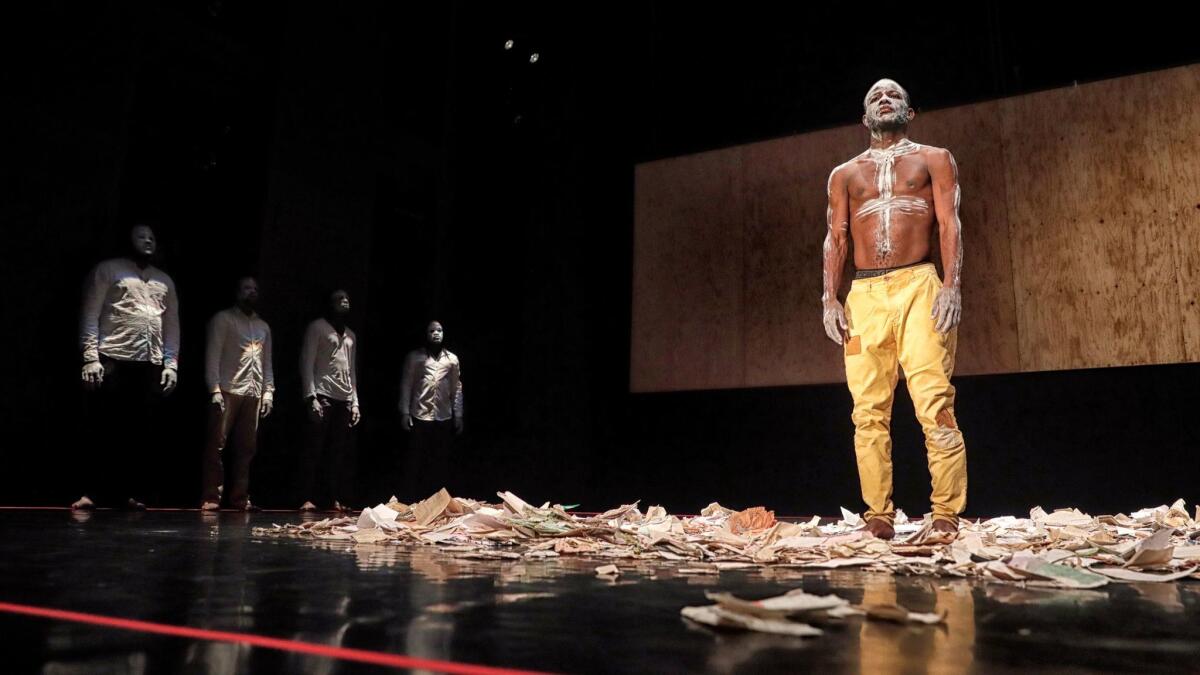Review: The incomparable political art of Congolese choreographer Faustin Linyekula

- Share via
Faustin Linyekula’s “In Search of Dinozord,” which opened REDCAT’s season Thursday night, is breathtaking political art. It is breathtaking not because the Congolese dancer, choreographer and theater maker takes your breath away in the colloquial sense with spectacular movement, although he is certainly capable of that. It is breathtaking because he leaves you in awe of, and deeply conscious of, the very act, and meaning, of breathing.
You may find that your lungs don’t function as effortlessly after 90 minutes with “Dinozord” as they did when you entered the black-box theater.
That there is no one like Linyekula making this kind of work is readily evident from the protest art currently grabbing our attention. All of it is a kind of power trip. We can argue about the value of an athlete taking a knee during the national anthem or whether the Guggenheim Museum in New York, under pressure from animal rights groups over a video showing mistreated dogs originally included in an exhibition of recent art from China, is condoning the very censorship that the work protests.
But what is common in these activities, as it is in nearly all political art, is the exertion of power, people taking matters in their own hands. Linyekula does that too — but literally, and in a profoundly and radically different way.
“Dinozord” begins with a blast of electronic music. The dancer stands expressionless on the stage to the far right of the audience. His face is covered in white paint. He is still but for his right hand, which shakes as though a wire went directly from the amplifier to tendons serving as coils of a loudspeaker. All the energy of the sound is absorbed in his body.
Rather than redirecting power, as protest art feels it must do, Linyekula simply soaks it up, bravely, at times violently, and you fear possibly fatally, but never sanctimoniously.
“We do not know where we are going,” proclaims in French the website for Studios Kabako, which Linyekula founded in Kisangani, his hometown in the Democratic Republic of the Congo. “For those who think we’re wasting our time … well … we’re too smart for that.”
“Dinozord” began as Linyekula’s response to the political turmoil in Congo, which forced him into exile in France and elsewhere and resulted in the arrest and death of colleagues. Linyekula reflected on that in a work commissioned in 2006 by Peter Sellars for a festival in Vienna commemorating the 250th anniversary of Mozart’s death. To Linyekula, Mozart’s Requiem, written as the composer was dying in 1791, symbolized his own feeling that he and his Congolese artist colleagues were the last of a tribe.
That tribe does have new life. Studios Kabako, named after a writer who died of bubonic plague trying to escape political repression, is now a vital home to dancers, opera and hip-hop singers, visual artists, writers, actors and, wonderfully, comedians. “Dinozord” has become a work of memory and sadness as well as promise, employing Kabako dancers Jean Kumbonyeki Deba, Papy Ebotani and Yves Mwamba Bakadiasa along with countertenor Serge Kakudji and actor Papy Maurice Mbwiti.
That reclamation takes many forms. Fragments from Kabako’s writing are contained on torn sheets of paper in a battered red metal suitcase. They fall out, scattered like the ashes of the dead writer, and must be repeatedly collected.
The stories of the artists’ troubles are recounted, also in fragmented fashion, quietly, without anger, by Linyekula and Mbwiti. The music takes its own fragmented forms from recorded bits of Mozart’s Requiem strikingly sung by the Charles Lwanga Choir of Kisangani and organ music by Arvo Pärt. There are also live musical contributions from the forceful Kakudji, who has been attracting much attention in European Baroque music circles, and others. We hear hard-to-bear descriptions of torture. The former political prisoner Antoine Vumilia Muhindo speaks on video.
But through it all, and the essence of it all, is what we call dance, for lack of a better word. Linyekula’s is not the dance of describing music or reacting to music. It is neither the dance of expressing emotion nor the dance of distancing the dancer from motion.
Instead, the dancers swallow music like food and drink. They become inflamed by music as by a drug. And in so doing, they seem to protect us from harm.
“Dinozord” ends with a Kumbonyeki solo danced to Jimi Hendrix’s “Voodoo Chile.” He appears as a puppet of Hendrix, yet at the same time transforming every familiar guitar lick, every vocal inflection so that we no longer know where anything's going. On its own this was the greatest single example of solo dancing I’ve seen in a long time. Only it wasn’t on its own. Linyekula is too smart for that.
♦ ♦ ♦ ♦ ♦ ♦ ♦ ♦ ♦ ♦
‘In Search of Dinozord’
Where: RECAT, 631 W. 2nd St., L.A.
When: 8:30 p.m. Friday and Saturday
Tickets: $30
Info: (213) 237-2800 or redcat.org
Running time: 1 hour, 5 minutes
The biggest entertainment stories
Get our big stories about Hollywood, film, television, music, arts, culture and more right in your inbox as soon as they publish.
You may occasionally receive promotional content from the Los Angeles Times.








